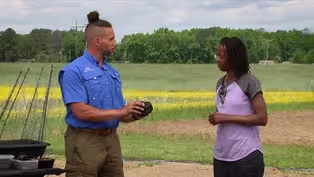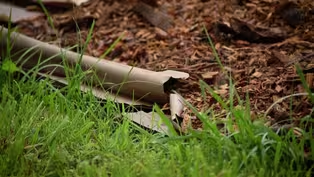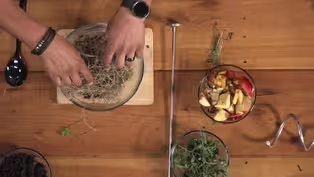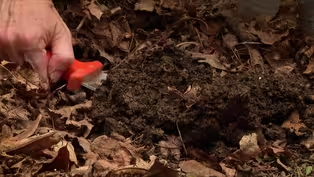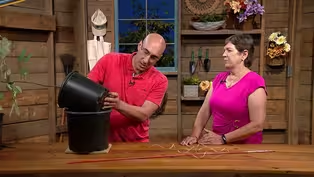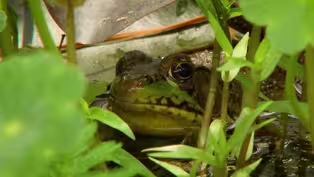Virginia Home Grown
Clippings: Healthy Gardens
Clip: Season 24 Episode 3 | 26m 46sVideo has Closed Captions
Healthy gardens are more than plants!
Shana Williams meets Derrick Gooden at Virginia State University in Petersburg to learn about biochar, an activated charcoal soil amendment. Peggy Singlemann visits meteorologist Andrew Freiden to talk about his work to add native plants, reduce runoff, and build better soil in his lawn and garden. Engage with us at facebook.com/VirginiaHomeGrown and vpm.org/vhg. VHGC 407.
Problems playing video? | Closed Captioning Feedback
Problems playing video? | Closed Captioning Feedback
Virginia Home Grown is a local public television program presented by VPM
Virginia Home Grown
Clippings: Healthy Gardens
Clip: Season 24 Episode 3 | 26m 46sVideo has Closed Captions
Shana Williams meets Derrick Gooden at Virginia State University in Petersburg to learn about biochar, an activated charcoal soil amendment. Peggy Singlemann visits meteorologist Andrew Freiden to talk about his work to add native plants, reduce runoff, and build better soil in his lawn and garden. Engage with us at facebook.com/VirginiaHomeGrown and vpm.org/vhg. VHGC 407.
Problems playing video? | Closed Captioning Feedback
How to Watch Virginia Home Grown
Virginia Home Grown is available to stream on pbs.org and the free PBS App, available on iPhone, Apple TV, Android TV, Android smartphones, Amazon Fire TV, Amazon Fire Tablet, Roku, Samsung Smart TV, and Vizio.
Providing Support for PBS.org
Learn Moreabout PBS online sponsorship(upbeat music) >>I'd like to, when I retire from my gig as a weather guy, I would like to turn into Johnny Persimmonseed.
I want to travel the countryside and convince everybody to put a persimmon tree in their yard.
>>Plants don't take up nutrients just by putting nutrients down onto the ground.
That has to be digested through the different microbacterias in the soil to then become available to the plants.
>>Yes.
>>So that's where the benefits of biochar come in, because biochar holds microbiology.
>>Production funding for "Virginia Home Grown" is made possible by the Mary Roper Davis and Robert Poore Roper Memorial Fund and by.
(critters chirping) (lively music) (lively music continues) (lively music continues) Welcome to Virginia Home Grown!
Today we are exploring garden health and what you can do to improve it.
Often that starts with your soil.
First, we travel with Shana Williams to Virginia State University in Petersburg to meet Derrick Gooden and learn about biochar, an amendment created by adding microbiology to charcoal, providing soil benefits that last hundreds of years.
Let's take a look >>Biochar is just biomass that has been burned at a high heat with low oxygen.
When that takes place, you're capturing pure carbon, and that carbon is what allows us to hold different types of microbacteria, fertilizers, and even help remediate soil by taking heavy metals out of it.
>>Could you show me how that process works?
>>Absolutely.
What you would need is a piece of charcoal.
>>Okay.
>>This piece of charcoal's too big.
So, the size that you want, if you put this into your soil, this is just gonna take up a lot of space.
What we really want is a size about this size, something that can be spread into the soil and that is gonna create drainage for poor soils.
So if I have clay, I can put this in there.
And even if I want to split this in half, I can split this in half, make more surface area, because this size of biochar has surface area the size of a tennis court.
Because although we cannot see this, if you put a microscope on here, there's gonna be pores all through here, it's a very porous material.
And in those different openings, you'll have the microbiology that finds its way in there, and it's able to stay in there and won't actually be washed away in the soil.
>>Okay.
>>So sometimes in the soil, if you get a heavy rain, you'll have leaching of nutrients and fertilizers.
Well, this will actually help stabilize that and keep those nutrients and fertilizers and microbiology in your soil and not be washed away.
>>And make it readily available for the plants- >>And make- >>To take it up.
Perfect.
>>Exactly, correct.
>>Perfect.
>>Correct, correct.
>>So we have the burnt char.
Now what do we need?
What's the next steps to charge it up?
>>The next step is to put biology- >>Okay.
>>Put life into here.
Because right now it's just pure carbon, that's it.
What I have here is leaf mold.
This is the easiest way and really the most accessible way for everyone to make biochar.
All they need to do is go out into their backyard, and if you don't have a backyard, go to a local park.
Find a secluded spot where there's a tree.
When you pull back that initial layer of leaves, you'll see a white sponginess.
That white sponginess will be mycorrhiza.
That's microbiology in the soil.
What we do is we put that into water.
And when you're putting this in, you don't need much.
There is a lot of microbiology in just a pin drop of the substance we have here, the media we have here.
>>Hmm.
>>So, just putting a handful in a five-gallon bucket like this, microbiology has already been added to the water.
>>Okay.
>>Really, this is all that you need.
But there are other things that you can use, of course.
Here we have dairy cow manure, but you can also use chicken manure, you can use rabbit manure.
>>Okay.
>>All of these items are gonna have microbiology in it, which are full of fungi, protozoa, bacteria, archaea, you know, some of the things I was mentioning earlier.
So, again, you don't need a lot.
For a five-gallon bucket, I just take a handful, sprinkle it in, you've added biology.
>>Perfect.
>>If you wanna supercharge your biochar, a great thing to use is worm castings.
This is some of the best and highest quality manure that you can find.
So now that we have all of our microbial life in a suspended solution such as water, when I add the char, I like to use a strainer.
>>Okay.
>>So you can use cheese cloth, you can use tea bags if you have a big enough tea bag.
But this is just a brew bag.
>>Okay, I can almost use almost any type of bag that allows the liquid to- >>Exactly.
>>Permeate the bag.
>>A sock, even, you can use.
>>Okay.
>>Anything that's permeable.
Now, you can add as much or little of the char as you want.
It's all specifically on what you need.
So we add the charcoal to the water here.
You can just place the bag over top of the bin like this.
>>Mm-hmm.
>>Mush it down.
>>Press it down in there.
>>Stir it in.
>>Okay.
How often do you need to stir it?
>>You need to stir this once a day.
>>For how long?
>>Optimally, you wanna do it for 30 days, minimum seven days.
>>Okay.
>>But the longer that you let it sit and get to that 30 days, the stronger it's gonna be, the more microbial life that's gonna be in the char.
>>So once I've created and then charged my biochar, how long does it last after I've applied it to the soil?
>>That microbial life will be there for hundreds of years.
>>Hundreds of years.
>>Hundreds of years.
>>Wow.
>>Because it's pure carbon, that carbon captures everything and keeps it in there.
>>Okay.
How would I apply it?
Can you show me?
>>Absolutely.
I have some that's been strained off here.
I will take it and spread it on the ground like this.
>>Okay.
So I don't have to think about it has to be an inch thick or whatever- >>Nope.
>>I just really need it to cover the surface of the soil.
>>That's correct, all you need to do is let it cover the surface of the soil right here.
>>Okay.
>>And now, you can do this by dumping a whole bunch in one area and then spreading it out with a rake or you can just, as I am, hand sowing it- >>Okay.
>>By just sprinkling it over top of the soil.
>>What if I just wanna replenish my five-gallon buckets or plant it?
Do I still just layer a light layer of it on top and then just lightly mix it in?
>>If you wanted to add it to just, like, a container, my suggestion would be to mix the soil with the biochar.
>>Mm-hmm.
>>And I wouldn't lay a top layer.
I'd just mix everything in.
Laying this on top here is just if you already have something established.
>>Okay.
>>If you have the ability to till it into the soil so that it's directly in there, that's the best way of doing it.
But for no-till purposes, which I know is very popular these days, would just be adding compost to the top of it.
So that way, your soil is getting the microbiology, and your compost, which already has microbiology in it, will have more microbiology.
>>Can you buy biochar already made?
>>You can.
There are people who produce biochar already made.
The only thing about that biochar is, for the most part, they aren't gonna tell you what they charged it with or even if they did charge it with anything.
It could be just charcoal that you're buying.
>>So, I could just simply go to the store and buy some hardwood charcoal and then charge it myself at home?
>>Absolutely.
What you want is 100% hardwood lump charcoal.
Take that charcoal and crush it.
And that needs to be broken down into quarter- to dollar-size pieces.
>>Okay.
>>Silver dollar-size pieces, yes.
>>Perfect.
Now, biochar is alkaline.
So if we add too much biochar to our soil, basically too much of anything can make it bad for you.
>>Absolutely.
Everything in moderation.
And I would even suggesting before adding biochar to your soil, getting a soil test done- >>Perfect, yes.
>>You getting a soil analysis done to see where the organic content in your soil is.
Because if your organic content is high enough, you might not even need biochar.
>>Okay.
>>But if it's too low and you have minimal organic matter, biochar is gonna help with that.
>>You teach classes or workshops here at Virginia State?
>>Yes, I have workshops here at Virginia State.
At least once a quarter, I do a biochar workshop.
Those are free to the public.
Even if you aren't a farmer, you can come and check out some of our workshops and some of the other cool things that we do.
>>This is good information.
>>Yeah.
>>Thank you for sharing.
>>Absolutely.
>>You know, and I'm looking- >>It was my pleasure.
>>Forward to trying this out and hey, making my soil even healthier.
>>Absolutely.
And as always, if you have any questions, feel free to reach out to the Virginia State University Small Farm Outreach Program.
We're here to help.
Healthy soil is key to healthy plants.
A comprehensive soil test can tell you not only the pH of the soil, but also how much organic matter is in your garden bed, which is an indicator of the soil's quality and fertility.
Next, Dr. Robyn Puffenbarger has some tips to share for maintaining great soil in raised beds and how you can avoid compaction by keeping the soil covered with organic material.
(playful music) >>The big three when you're thinking about gardening, are sun, water, and soil.
And the one you probably have the most control over is your soil.
Thinking about where you want your garden and what kind of substrate you have to grow your plants in is really important for successful plant growth.
Here in my garden, where I'm doing my vegetable, herbs, and flowers, one of the things I was really thinking about is how I don't want to compact the soil.
Once we've fluffed the soil a bit, and added some amendments, we don't wanna walk on it anymore.
So one of the things that we've done is put in permanent paths with mulch, and then I can just walk, or use my heavy-duty wheelbarrow anytime I want, and not worry about compacting the soil where I want my plants.
The next thing I thought about was how to keep weeds from growing.
And one of the big things I do is put on lots of leaves, or grass clippings, whatever I've got on hand.
That makes a layer that the weeds cannot either germinate or get through.
And you can see here where I've got leaves, there's no green growth.
And as we move away to the side, where the material has degraded over the fall to now this spring, you can see there's some little weeds starting to come in.
Another thing that adding compost and organic material, like this mulch, helps with is the soil moisture.
So as I start to pull the leaves away, you can see the darkness, you can feel the dampness of this soil compared to the soil here, which has been exposed to the sun, and is beginning to dry out.
Depending on what you're planting, you may have to pull the leaves completely away, because you are using little tiny seeds that will need the sunlight to germinate.
But I'm about to plant tomatoes in this bed, so I'll be able to leave this mulch all around the plants.
One of the things that I find really important is doing a soil test.
That helps me know what the soil micronutrients are like, and what the pH is like.
For this kind of garden bed I have here, just a regular neutral pH is important.
Another thing I like having is a little pocket soil thermometer.
That tells me the right temperature.
I'm here in the Shenandoah Valley, and it's just starting to warm up enough, and my soil thermometer is reading 60 degrees.
That means it's time for me to start planting my tomatoes in this bed, but it's not 70 yet, so it's not time for okra.
So one of the things, by not walking on my soil, by not compacting it, I can easily slide my soil knife right in when I'm ready to plant my plants, and just pop the soil right up.
Oh, and here's some earthworms, so they're eating the organic material, and providing their castings as extra fertilizer.
I've got some chunks of clay mixed in with my better soil that has some organic material, so I've got a nice soil bed ready to go.
Adding compost, adding organic material, and using chemicals only when necessary will help you have healthy soil, healthy plants, and a wonderful garden.
Have fun out there planting your plants.
I also use organic mulches to retain soil moisture and feed the soil microbial life.
It's a great way to keep materials like grass clippings and leaves out of the landfill.
And now I visited with our local meteorologist Andrew Freiden to see how he is working to transform his traditional landscape into a more eco friendly environment, which includes frogs.
>>You don't have what I would call a typical front yard.
>>Yeah, it's a front yard that used to be a typical front yard, then we moved in and things started going downhill.
(Peggy laughing) Although, I think uphill.
>>I wouldn't say downhill.
>>Yes!
Right?
(Peggy laughing) We've made some choices that aren't normal.
There's a couple fruit trees, these are persimmon trees in the front.
But we started out, we cut out some big long beds and we put wildflowers in, and it worked wonderfully.
It attracted butterflies immediately, and pollinators.
>>Wonderful.
>>And neighbors, like people are like, "What's goin' on in your front yard?"
And so, the other day, my wife cut some flowers and gave 'em to like a 3-year-old girl who was ridin' a bike with her dad.
And so we're talking and we're meeting people.
And I love lookin' at the front yard and seeing stuff producing instead of just being grass.
>>Yes, it's so much fun, including the vegetables I see that you have.
>>My daughter made these raised beds.
>>Ooh, great.
>>Old pallets, not treated, it was all natural stuff.
>>Right.
>>And she did it for a project.
And so, this is our vegetable garden, and vegetable gardens doesn't really work for me entirely 'cause it's work.
>>Yes.
>>Ask your gardener friends around the corner, they're working.
(Peggy laughing) And so, I like the stuff that we put in, and once you get it started, it's like, "We got this, leave us alone.
We'll live here just fine."
That's my plan.
>>Well, like your berries.
>>Yeah.
Blackberries, raspberries, and they are vigorous and they're happy.
This is their second year, we got a few berries last year.
We anticipate this year, they're primocane, so the new growth produces the berries.
There's some blossoms already.
>>Right.
>>But how cool is it to, instead of having grass, have a spot where your kids will come out and pick berries and eat them.
>>Fresh berries.
>>And I don't have to worry about them spreading.
People say, "Well, you're gonna have raspberries all in the front yard," well no, because I have turf that I'm cutting with the mower.
So anything that sprouts up just gets cut down- >>Gets cut back down.
>>It stays where it's supposed to be.
>>Speaking of turf, I see you've allowed the weeds, what we would call weeds- >>Hey!
How dare you.
>>The other plants move in.
Yes.
(laughing) >>I've heard you say that weeds are just plants somewhere where you don't want them.
>>Exactly.
>>So, I like these.
I want 'em here, I don't think they're weeds.
Clover, violet, they're all here.
>>I think it's fantastic.
>>Yeah.
>>Because what it does, it makes that lawn a little bit more diverse.
And the pollinators, they're able to come to your lawn.
Really, you're just adding to the biodiversity.
>>Yeah, so it's cool.
And it also, again the cheap and lazy part of me, I'm not paying to kill them.
So it doesn't look, as some people would say, "perfect."
>>Right.
>>But to me, it looks absolutely perfect.
It's growing and I'm not doing anything to it other than mowing it.
And I kinda hate mowing too, but that's a different story.
But, I'd love to cut more... Hopefully, you come back in a few years and there's more beds and less turf grass.
>>That would be great.
I love the fact that you're leaving things for even our pollinators.
>>Sometimes when I'm mowing and there's a really vigorous patch of clover with the white blooms on it and there's bees on it, I'm like, "Oh okay, I'll go around you.
I'll get ya next time."
>>Right.
>>Yeah.
>>It's okay, be a little flexible.
>>Yeah.
>>But I like your walkway too.
>>Oh yeah, this used to be an enormous curved asphalt driveway.
>>Oh my.
>>And one of the first things we did when we moved in here was like, "This thing is gonna take a lot of maintenance, I think we gotta get rid of this thing."
And so we got some money, some help from VCAP, Virginia Conservation Assistance Program, for the cost that it was to take that out and to put this walkway in.
>>That's fantastic.
Yes.
And the walkway you put in is bricks set in sand.
So that's permeable, so when it rains, the water goes down and replenishes our groundwater which is what we need.
>>Yes, it stays here, it doesn't leave.
And speaking of staying here and not leaving, I don't want anything to leave.
All the resources that hit here, the sun, the water, I'd like it to stay on here.
And I think of the leaves as a resource too.
So we have these big trees and they drop leaves all over the place, and I hate seeing people take the leaves and bag 'em up, or suck them up, or put 'em out on the street and get 'em outta here.
There's all that good stuff in those leaves.
>>So many nutrients.
>>Yes, so I'm like, "I'm keepin' it."
So I keep every leaf on the property, that's my plan.
>>Well, I noticed a compost pile in the back.
>>Oh yeah, some leaves.
>>Let's go take a look.
>>Let's check it out.
(birds chirping) Is anybody's compost pile pretty?
I mean, ours isn't very pretty, but we're keepin' the stuff here, that's the goal.
>>Yes, you're keepin' it here and you're workin' with it, and you're letting all those wonderful biological fungi do their job.
>>And it's not too far from our frog pond, which is like my favorite thing in our backyard.
>>And what a great frog pond you have.
>>Thank you, and I appreciate it.
I mean, we worked pretty hard on it, it was a lotta digging.
>>You showed me the photos, how deep you dug this.
(laughing) >>Yeah, so they say when you make it, you have to make it pretty deep in the middle to allow some frogs to overwinter.
You can hear the frogs there.
>>Yes.
>>That's a green frog, I'm pretty sure.
>>Okay.
>>But they're down in the middle and the middle's deep, and then there's a shelf on the outside.
>>Yes, which also allow the birds to come and bird bath.
>>Oh my gosh, I wish they were here.
I think we scared them away, but this is the prime spot where the neighborhood birds come to get clean or to play, I don't know what they're doin'.
But that's been an added bonus that we didn't think was gonna happen, is that all these birds were gonna come in here and visit all the time.
>>And I applaud you for using the rainwater off of your roof to fill your frog pond.
>>So it was a little bit of an elevation issue to figure out how to do it.
>>Yes.
>>So we had to build a little hill, but we've run a PVC pipe that goes from one section of our roof right into the frog pond.
So, it has to get really hot and really dry in the summer for us to get the hose out.
(frog honking) I know.
(laughing) >>What a ham.
(Peggy and Andrew laughing) >>Somebody's even more of a camera hog than I am.
Do you mind stepping aside so I can get set?
(Peggy laughing) But the fact that that, unless it's really hot and dry, it stays pretty full.
Like every time it rains, it just fills up.
And so it's been a nice addition to the yard and I think it's easier than people think, I encourage ya to look it up.
>>Yeah.
>>"Hey, could I put a frog pond, or at least a rain garden in my backyard?"
It's a pretty cool thing.
>>And those are two different things 'cause this has a liner, so it holds water.
Where a rain garden does not have a liner, it's shallow, more like a crater, and it has soil in it to improve the percolation of the water down into the water table.
And most times, rain gardens are dry, they're only wet when it rains.
>>Yeah, and that one, I don't think you have to worry too much about mosquitoes.
In this case, we do have to worry, so we treat them with these mosquito bits which are pretty decent, they're not like a horrible thing.
And you put it in there to make sure the mosquitoes aren't taken off in here.
>>Yes, it's just Bacillus thuringiensis, I use 'em all the time.
>>That's what I was gonna say, but okay, if you wanna... (Andrew and Peggy laughing) It's so fun to hang out with you 'cause I have no idea if you were totally making this up, but I'm gonna Google it later, okay?
>>You do that.
(Peggy and Andrew continue laughing) But also, Andrew, I applaud you because you purchased a house with a very, I'll say traditional landscape.
>>Yes.
>>People planted what were popular.
But now as you're moving through it, you're kind of infusing those native plants.
>>Yeah, we're doing our best to take out what we can and put in what should be here.
And so you've been very kind, and when you say traditional plants, I hear you say invasive non-natives that shouldn't be here.
And I feel it and I know it, and every time we're out and I look, I go, "Oh, that lily, right, shouldn't be there.
Let's get rid of it."
And you said, I have a great alternative, like right over there, that purple stuff.
>>Yes, you've got spiderwort, or spider lily, depending on the common name.
But it's Tradescantia, and it's native here to Virginia.
>>And when am I gonna split that up?
>>You can split that up in the fall, or you can just let it go to seed and sprinkle the seed.
>>Alright, I'll do that.
And then when I knew you were coming to visit, I'm like, "Peggy Singlemann is coming to my yard to judge me."
>>(laughing) No, I'm not.
>>You know, (laughing) it's like if a Picasso was coming to look at my finger paintings, right?
I'd be like, "Uh, this is gonna be a tough day for me."
But, I'm trying to embrace like gardening or taking care of your property isn't one prize at the end.
>>Yeah.
>>I'm getting little successes and little prizes along the way.
It's not like it has to be perfect, those little steps every year can move you toward a better garden.
>>Exactly, and it's the holistic picture we're looking for.
>>Yeah.
>>And if it takes just a few more years than you thought, or 10 years, but you're still making your way toward that goal.
Well thank you, Andrew, for kindly showing us your place and the work you're doing one step at a time.
>>Alright, I appreciate it.
Also, I'd like to say, thanks guys for on cue making frog noises.
Those are our green frogs of the Freiden family.
(frog croaking) Controlling runoff is one of the keys to soil health.
We should all consider how to keep rainfall on our property as heavy precipitation events become more frequent.
And now Amyrose Foll shares what she is sowing in her Wildflower meadow to add plant diversity to the landscape.
(light clacking sounds) >>I am in my meadow today and we have been curating a collection of native wild flowers here.
I'm broadcasting seeds, it's fall.
Fall is an excellent time to be planting wild flowers.
I have already some fire weed, some bluemist, goldenrod and in the back, there's boneset, a bevy of different kinds of native wild flowers here and the reason I'm doing it in the fall is because planting in the fall will give you about a two week headstart on blooms versus planting in the spring, and it really allows those seeds to settle over the wintertime.
Some seeds require a stratification process, which is a cold treatment, and they need certain hours of cold to be able to sprout and for those seeds to grow so this is the perfect time to do it.
You can buy already stratified seeds online or get them from other seed keepers, but this is great if you have them.
No muss, no fuss.
Mother nature will do the work for you.
Today we're adding some variety.
I have some goldenglow rudbeckia, I've got evening primrose and we've got bundle flowers.
We've got different heights, we've got different colors and different bloom times.
Our evening primrose will start blooming mid-summer, beginning of summer till fall, and they bloom at night.
They're native to this area.
We've got bundle flowers, they're white and shorter and then our goldenglow rudbeckia is gonna be taller and yellow and it will beautifully compliment this bluemist throughout this field that we planted previously and they are going to be perfect to put in now.
They'll settle into the ground and naturally sprout in the spring.
As a farmer, it gives me something to do a little farther into the season when the varieties that you can plant start to get smaller and smaller.
By getting these seeds in the ground now, you're gonna have an earlier food source, they'll be ready for those pollinators come spring.
It's also a great time to plant trees and shrubs for that spring bloom, so I encourage you to try this.
It's so satisfying and it gets you out in the garden farther into the season.
As we have seen, there are many strategies for creating a healthier and more eco friendly garden.
We hope you try some of these ideas to not only create a bountiful landscape, but one which is sustainable.
See you soon and until then, remember gardening is for everyone.
We are all growing and learning >>Production funding for Virginia Home Grown is made possible by (bird cawing) the Mary Roper Davis and Robert Poore Roper Memorial Fund and by... (birds chirping) (bright instrumental music) (bright instrumental music continues) (bright instrumental music continues) (bubbly electronic outro)
Video has Closed Captions
Clip: S24 Ep3 | 8m 40s | Learn about a amendment made with activated charcoal to improve soil health and structure (8m 40s)
Cardboard for suppressing weeds
Video has Closed Captions
Clip: S24 Ep3 | 2m 48s | Create a weed barrier in your garden by reusing cardboard packaging (2m 48s)
Video has Closed Captions
Clip: S24 Ep3 | 6m 42s | How to make your own compost at home (6m 42s)
Video has Closed Captions
Clip: S24 Ep3 | 3m 23s | Maintain soft and fertile soil in raised bed gardens (3m 23s)
Video has Closed Captions
Clip: S24 Ep3 | 6m 18s | How to pot up a young tree and encourage vertical growth (6m 18s)
Transforming a traditional landscape
Video has Closed Captions
Clip: S24 Ep3 | 7m 53s | Adding native plants, reducing runoff, and improving soil creates an eco-friendly garden (7m 53s)
Providing Support for PBS.org
Learn Moreabout PBS online sponsorship

- Home and How To

Hit the road in a classic car for a tour through Great Britain with two antiques experts.












Support for PBS provided by:
Virginia Home Grown is a local public television program presented by VPM
